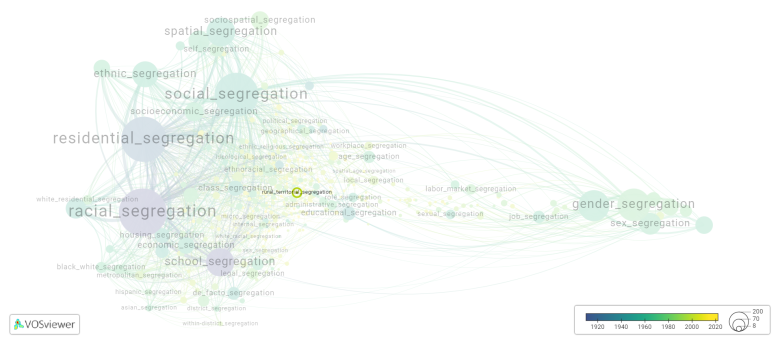Rural territorial segregation: Difference between revisions
(Creating page) |
(Creating page) |
||
| (8 intermediate revisions by the same user not shown) | |||
| Line 1: | Line 1: | ||
===== Date and country of first publication<ref>Date and country of first publication as informed by the Scopus database (December 2023).</ref>===== | |||
2009<br> | 2009<br> | ||
United States | United States | ||
===== Definition ===== | |||
Rural territorial segregation refers to the spatial separation of different ethnic or racial groups within rural areas. It is a phenomenon that is caused by various factors, including historical patterns of settlement, economic disparities, and discriminatory practices. | Rural territorial segregation refers to the spatial separation of different ethnic or racial groups within rural areas. It is a phenomenon that is caused by various factors, including historical patterns of settlement, economic disparities, and discriminatory practices. | ||
| Line 17: | Line 16: | ||
Efforts to address rural territorial segregation involve addressing structural and systemic issues. This includes promoting inclusive policies and legislation that promote fair access to housing, education, and healthcare services in rural areas. Additionally, initiatives to provide economic opportunities and improve infrastructure in disadvantaged rural communities are essential in reducing territorial segregation. | Efforts to address rural territorial segregation involve addressing structural and systemic issues. This includes promoting inclusive policies and legislation that promote fair access to housing, education, and healthcare services in rural areas. Additionally, initiatives to provide economic opportunities and improve infrastructure in disadvantaged rural communities are essential in reducing territorial segregation. | ||
==See also== | ==See also== | ||
==Related segregation forms== | |||
Rural territorial segregation is frequently discussed in the literature with the following segregation forms: | |||
[[racial segregation]], [[territorial segregation]] | |||
[[File:rural_territorial_segregation.png|780x780px]] | |||
This visualization is based on the study [[Segregation_Wiki:About| The Multidisciplinary Landscape of Segregation Research]]. | |||
For the complete network of interrelated segregation forms, please refer to: | |||
* [https://tinyurl.com/2235lkhw First year of publication] | |||
* [https://tinyurl.com/2d8wg5n3 Louvain clusters] | |||
* [https://tinyurl.com/223udk5r Betweenness centrality] | |||
* [https://tinyurl.com/244d8unz Disciplines in which segregation forms first emerged (Scopus database).] | |||
==References== | ==References== | ||
==Notes== | ==Notes== | ||
<references /> | <references /> | ||
== | {{NoteAI}} | ||
==Rural territorial segregation appears in the following literature== | |||
Feinberg H.M. | Feinberg H.M., Horn A. (2009). South African territorial segregation: New data on African farm purchases, 1913 1936. ''Journal of African History'', ''50''(1), 41-60. https://doi.org/10.1017/S0021853708003964 | ||
Latest revision as of 07:17, 16 October 2024
Date and country of first publication[1][edit | edit source]
2009
United States
Definition[edit | edit source]
Rural territorial segregation refers to the spatial separation of different ethnic or racial groups within rural areas. It is a phenomenon that is caused by various factors, including historical patterns of settlement, economic disparities, and discriminatory practices.
In many rural areas, there is a long history of racial or ethnic groups being geographically concentrated in specific regions. This can be attributed to historical patterns of settlement, such as migration and colonization, which often led to the establishment of segregated communities. For example, in the United States, rural areas in the South were historically characterized by racial segregation, with African Americans being confined to specific rural regions.
Economic factors also contribute to rural territorial segregation. Disparities in wealth and resources can result in certain communities being marginalized and isolated. Limited access to employment opportunities and basic services can further deepen the segregation between different groups in rural areas.
Discriminatory practices, both formal and informal, play a significant role in rural territorial segregation. These can include discriminatory housing policies, such as redlining, which systematically exclude certain groups from accessing housing in specific areas. Discrimination in education and healthcare services can also contribute to the segregation of rural communities.
Rural territorial segregation has various consequences for the affected communities. It can perpetuate social and economic inequalities, as segregated communities often face limited opportunities for socio-economic mobility. It also leads to the erosion of social cohesion and can fuel tensions and conflicts between different groups.
Efforts to address rural territorial segregation involve addressing structural and systemic issues. This includes promoting inclusive policies and legislation that promote fair access to housing, education, and healthcare services in rural areas. Additionally, initiatives to provide economic opportunities and improve infrastructure in disadvantaged rural communities are essential in reducing territorial segregation.
See also[edit | edit source]
Related segregation forms[edit | edit source]
Rural territorial segregation is frequently discussed in the literature with the following segregation forms:
racial segregation, territorial segregation

This visualization is based on the study The Multidisciplinary Landscape of Segregation Research.
For the complete network of interrelated segregation forms, please refer to:
References[edit | edit source]
Notes[edit | edit source]
- ↑ Date and country of first publication as informed by the Scopus database (December 2023).
At its current state, this definition has been generated by a Large Language Model (LLM) so far without review by an independent researcher or a member of the curating team of segregation experts that keep the Segregation Wiki online. While we strive for accuracy, we cannot guarantee its reliability, completeness and timeliness. Please use this content with caution and verify information as needed. Also, feel free to improve on the definition as you see fit, including the use of references and other informational resources. We value your input in enhancing the quality and accuracy of the definitions of segregation forms collectively offered in the Segregation Wiki ©.
Rural territorial segregation appears in the following literature[edit | edit source]
Feinberg H.M., Horn A. (2009). South African territorial segregation: New data on African farm purchases, 1913 1936. Journal of African History, 50(1), 41-60. https://doi.org/10.1017/S0021853708003964
